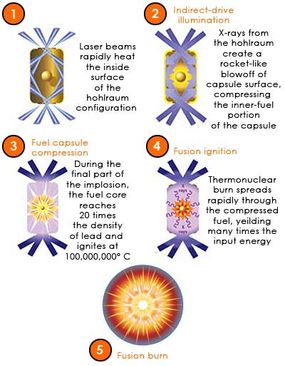Fusion Reactors: Inertial Confinement
Since the 1960s, the National Ignition Facility (NIF) at Lawrence Livermore Laboratory has been working upon a complex task—figuring out how to use lasers to ignite fusion reactions.
Inside the facility, as many as 192 laser beams are fired into a centimeter-sized hollow cylinder called a hohlraum, in order to generate X-rays that bombard a tiny capsule containing hydrogen isotopes. The goal is to implode the capsule, blow off its surface and heat the isotopes, duplicating the intense conditions found inside the cores of stars and giant gas planets. That implosion occurs so rapidly that it allows fusion reactions to take place before the fuel can disassemble [source: LLNL].
Advertisement
If the process works correctly, fusion ignition will occur at the moment when the alpha-particle energy going into the center of the capsule is equal to the energy losses from emitted X-rays and electron heat production. The goal is to create "burning plasma, " in which a wave of fusion reactions spreads into fuel surrounding that hot spot. If enough alpha particles are absorbed, the temperature of the fuel will be high enough to generate a self-sustaining thermonuclear reaction, leading to ignition [source: LLNL].

But as of 2020, reaching ignition in the NIF has proven to be a lot tougher than initially was envisioned. But as the NIF website notes, with each experiment, scientists gain more knowledge. The use of high-resolution 3-D modeling, for example, has helped them to better understand how the process works [source: LLNL].
In 2018, scientists at NIF achieved a record when they fired 2.15 megajoules of ultraviolet energy into the target chamber. They've also managed over the years to increase the implosion velocity and raise the pressure in the center of the implosion three or four times what they originally could generate. Most importantly, for the first time ever in a laboratory setting, they've seen initial signs of reaching the threshold where the energy generated by alpha particles stimulating fusion reactions in the fuel exceeds the kinetic energy from the implosion. Eventually, if they're able to contain the process better, they'll be able to achieve fusion ignition [source: LLNL].
Like the magnetic-confinement fusion reactor, the heat from inertial-confinement fusion will be passed to a heat exchanger to make steam for producing electricity.
